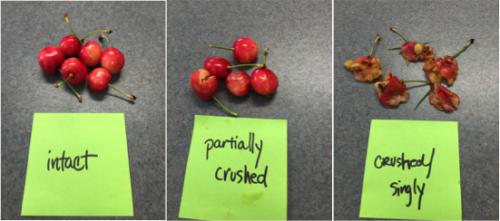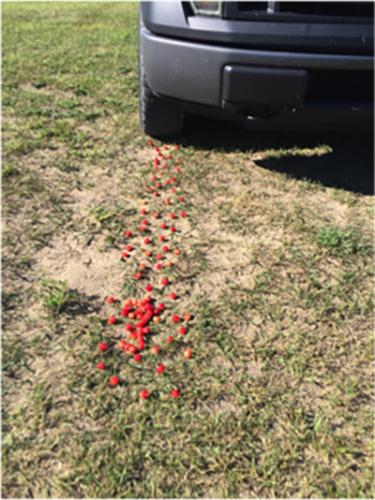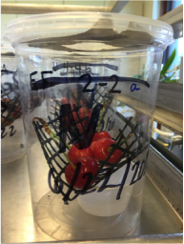Considerations for hail-damaged cherries after storms
With the recent storms that moved through northwest Michigan, growers should assess damage to determine future management strategies.

Cherry orchards were impacted by hail on July 8, 2016, and growers should carefully weigh options to determine future management strategies. First, growers should assess the level of damage as the outcome of this assessment will determine the next steps. If the damage was fairly extensive, and if the grower has crop insurance, Michigan State University Extension recommends growers call their crop insurance agent as soon as possible. Particularly if the damage was widespread and rendered the crop unmarketable, growers should discuss the options with the crop insurance agency. If the crop is unmarketable, growers should consider minimizing management applications to reduce costs in these blocks.
Even with the threat of spotted wing Drosophila (SWD), more insecticide applications will obviously increase costs in a block that will not provide income. Growers need to keep leaves on for next year, so continue managing for cherry leaf spot. If growers minimize insecticide and fungicide applications, they should communicate this decision to neighboring farmers. As we have mentioned in the past, SWD populations can build quickly in unsprayed fruit and move into blocks that are intended for harvest. Growers should also consider removing the crop from the trees to minimize infestation from SWD. More information on removing cherries from the tree and strategies for minimizing SWD infestations are forthcoming based on ongoing trials at the Northwest Michigan Horticulture Research Center.
Secondly, if the fruit is on the borderline of marketability, we recommend growers contact their processors to discuss options for this damaged, but potentially harvestable fruit. Processors that have a juice market may want growers to continue managing this fruit for this particular market. Growers should also consider other processors that may be interested in the juice market. However, if the fruit will be used for juice, cherries will likely need to hang for longer to increase brix levels. The longer the fruit hangs, the longer management will be needed. Growers will need to decide if fruit will make it to harvest and be worth the extra sprays and costs associated with these applications. Growers need to be realistic if they can justify continuing management if the crop will not ultimately be marketable in the end.
Again, growers should be assessing the level of damage to tart and sweet cherries, particularly if harvest is still quite far off. The northwest region is predicted to harvest 165 million pounds of tart cherries, and removing that size of crop even under optimal conditions would have been a challenge. After this storm, there are varying levels of damage to sweet and tart cherries, and growers need to decide if they will make it to harvest with a marketable crop or if they should stop management now.
If the fruit has minor damage, growers will likely be able to manage insects and diseases to make it to harvest time. More intense damage will be more difficult to keep clean moving forward, and growers need to consider if they can make it to harvest with clean, disease-free fruit. If growers chose to move forward with harvesting damaged blocks, the quicker the damaged blocks can be harvested, the better.
Damaged fruit will be more likely to be infested by insects, particularly SWD. Spray programs in damaged blocks will need to be ramped up to prevent infestation. This scenario may be difficult to swallow and particularly challenging for growers as they are already spraying diligently to prevent SWD infestation. However, wounded or cracked flesh of a ripe cherry will provide an easy entry point for SWD egglaying; therefore, growers will need to be even more thorough in managing SWD. Laboratory studies conducted at the Northwest Michigan Horticulture Research Center have shown SWD females prefer to lay eggs into cracked or smashed fruit compared to intact fruit (Photo 1).
Damaged fruit and SWD fruit infestation trial
Methods: Ripening fruit were collected from sweet cherry trees June 22, 2016. Fruit was dividing into nine treatments:
- Intact fruit
- Partially crushed/cracked by gently squeezing between fingers
- Crushed and laid singly
- Crushed and laid in pile

Photo 1. Treatments 1-3 as listed above (intact, partially crushed, and crushed and laid singly).
To simulate mechanically crushing or mashing of fruit by a farm implement, we positioned fruit in front of truck tires in the orchard row and drove over the piles of fruit (Photo 2). Some fruit were picked up singly and others in piles. All fruit was brought back to the lab and set up into bioassay containers (Photo 3). Each treatment was replicated five times where five fruit were added along with five male and five female SWD. Bioassay containers are allowed to sit at room temperature for 10 days before the number of newly emerged SWD are counted.

Photo 2. Driving over fruit to simulate mechanical crushing.

Photo 3. Fruit in bioassay containers.
Results show that cracked fruit squeezed gently by hand had the most SWD that survived until adulthood; they could produce multiple generations in this fruit (Figure 1). These fruit would be similar to fruit that was cracked or damaged by hail in the recent storm. Therefore, we conclude that cracked fruit, such as those that are damaged or cracked by hail, are preferred by SWD and can rapidly increase the SWD populations in an orchard. Cracked fruit are the most susceptible fruit to SWD infestation.

Figure 1. Number of spotted wing Drosophila (SWD) adults in damaged and non-damaged cherries.
Additionally, damaged fruit will be more susceptible to diseases, such as American brown rot and Alternaria. American brown rot is a particular concern in blocks that have been damaged. If the fruit will not be harvested, justifying the cost of continuing management programs is difficult. On the other hand, minimizing the potential for brown rot in orchards this season will reduce inoculum for next season. An SDHI fungicide (Merivon or Luna Sensation) tank-mixed with Captan is the best option for controlling American brown rot at this point in the season. However, one spray may not provide enough control through harvest, particularly if harvest goes long. In this case, growers should follow the SDHI application with 12 ounces of Indar tank-mixed with Captan. Again, cracked fruit are more susceptible to American brown rot infection than intact fruit.
Lastly, the current restriction on the tart cherry crop is 29 percent, and as a result, fruit may have been put on the ground even without the recent damage. However, we remind growers that the fruit used for diversion needs to be marketable. The level of damage may influence the decision if the crop is marketable or not. We recommend that if growers intend to divert partial or whole blocks, they continue to adequately manage for insects and diseases to ultimately have marketable cherries.
Dr. Rothwell’s work is funded in part by MSU’s AgBioResearch.



 Print
Print Email
Email



